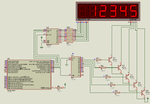actor23
Member level 3
Hello All ;
I've been working the circuit schematic of 5 digit 7 segment leds.
My ICs and discrete elements are :
TPIC6b595 (Shift Register)
CD4017 (Decade Counter)
5xNpn BJT
5 Digit Common Anode Led Display
5 Buttons directly connect to uC
My question about coding. Shift register' inputs driven by uC deciding by the buttons. Which are set,up,down,shift,mode,etc. I am planning to use 25Hz-50Hz clock signal to feed the CD4017 which is used for selecting the digits. In the timer interrupt vector, should i update the data on the each digit ? Or, how i can do this ? When a button is pressed an interrupt is created should it be updated in the interrupt vector by writing value in an array ?
Im sending a bit messy schematic for you,it is hand drawing. Hope one who did this before want to help me.
Thanks in advance.
Best Regards

I've been working the circuit schematic of 5 digit 7 segment leds.
My ICs and discrete elements are :
TPIC6b595 (Shift Register)
CD4017 (Decade Counter)
5xNpn BJT
5 Digit Common Anode Led Display
5 Buttons directly connect to uC
My question about coding. Shift register' inputs driven by uC deciding by the buttons. Which are set,up,down,shift,mode,etc. I am planning to use 25Hz-50Hz clock signal to feed the CD4017 which is used for selecting the digits. In the timer interrupt vector, should i update the data on the each digit ? Or, how i can do this ? When a button is pressed an interrupt is created should it be updated in the interrupt vector by writing value in an array ?
Im sending a bit messy schematic for you,it is hand drawing. Hope one who did this before want to help me.
Thanks in advance.
Best Regards

